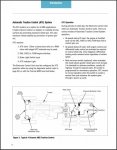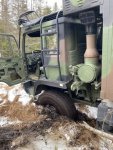Third From Texas
Well-known member
- 2,837
- 6,669
- 113
- Location
- Corpus Christi Texas
I've been stuck before and had people say "you're not in four-wheel-drive" to which I reply "it's not a four-wheel-drive truck" which always results in a puzzled look. Heh
Something GeoPen and I briefly discussed a couple years ago came to mind the other day as I was driving. As I understand it, with the LMTV all-wheel-drive system, if a wheel loses traction, the diff applies all power to the opposite wheel. In many situations (like soft sand, mud, etc) that can result in only one tire turning per axel and you basically make matters worse.
Some owners opt for lockers to resolve this issue but as we all know, they are all-or-nothing (due to the lack of e-lockers or air-lockers). If you have Detroit-style lockers, you basically create a one piece axel to improve traction. This of course presents issues (skipping in turns, etc) that aren't desirable.
So back to the discussion GeoPen and I had sometime back. We were talking about the inability to independently apply brake pressure to each tire. Of course, the trucks aren't set up to allow for that. On a hydraulic brake systems, you can use a proportioning valve to adjust your braking front or rear (but I don't have the slightest clue if this can be done with air brakes but I suspect that it very well could). And you can take things a step further with rear cutting brakes that can limit each rear tire independently on sand cars, etc. But as I said, our air systems aren't really designed with that in mind.
But lets say you could in fact use a handle to apply pressure to the brakes in one axel or the other (or even each tire independently) via something akin to a cross between a proportioning valve and a set of "cutting brake" handles that would allow you to apply enough pressure to an axel (or a tire) to trick the diff into keeping power to both wheels on that axel. Not enough to stop the wheel, just to create enough resistance so the diff doesn't go into slip mode and the wheel stays under power. If you had such a handle(s) in the cab, wouldn't that technically result in all wheels then staying under power when they would normally crap out and let one on each axel slip?
My A1R has ABS and I'm not sure how that comes into play (I still assume that it functions per axel and not per independent tire), but again it's a point I'm ignorant of with regards to the LMTV braking system. If the ABS *does* control the braking of each tire independently, then I think it could also be used to negate the limited slip issue. Even if not, I wonder if pulsing the ABS would be enough to stop the diff from slipping.
Just something that I think about from time-to-time. Especially when the Jeeps are circling my stuck LMTV and yelling "BRO, YOU'RE NOT IN FOUR WHEEL DRIVE DOOD"
Something GeoPen and I briefly discussed a couple years ago came to mind the other day as I was driving. As I understand it, with the LMTV all-wheel-drive system, if a wheel loses traction, the diff applies all power to the opposite wheel. In many situations (like soft sand, mud, etc) that can result in only one tire turning per axel and you basically make matters worse.
Some owners opt for lockers to resolve this issue but as we all know, they are all-or-nothing (due to the lack of e-lockers or air-lockers). If you have Detroit-style lockers, you basically create a one piece axel to improve traction. This of course presents issues (skipping in turns, etc) that aren't desirable.
So back to the discussion GeoPen and I had sometime back. We were talking about the inability to independently apply brake pressure to each tire. Of course, the trucks aren't set up to allow for that. On a hydraulic brake systems, you can use a proportioning valve to adjust your braking front or rear (but I don't have the slightest clue if this can be done with air brakes but I suspect that it very well could). And you can take things a step further with rear cutting brakes that can limit each rear tire independently on sand cars, etc. But as I said, our air systems aren't really designed with that in mind.
But lets say you could in fact use a handle to apply pressure to the brakes in one axel or the other (or even each tire independently) via something akin to a cross between a proportioning valve and a set of "cutting brake" handles that would allow you to apply enough pressure to an axel (or a tire) to trick the diff into keeping power to both wheels on that axel. Not enough to stop the wheel, just to create enough resistance so the diff doesn't go into slip mode and the wheel stays under power. If you had such a handle(s) in the cab, wouldn't that technically result in all wheels then staying under power when they would normally crap out and let one on each axel slip?
My A1R has ABS and I'm not sure how that comes into play (I still assume that it functions per axel and not per independent tire), but again it's a point I'm ignorant of with regards to the LMTV braking system. If the ABS *does* control the braking of each tire independently, then I think it could also be used to negate the limited slip issue. Even if not, I wonder if pulsing the ABS would be enough to stop the diff from slipping.
Just something that I think about from time-to-time. Especially when the Jeeps are circling my stuck LMTV and yelling "BRO, YOU'RE NOT IN FOUR WHEEL DRIVE DOOD"
Last edited:




